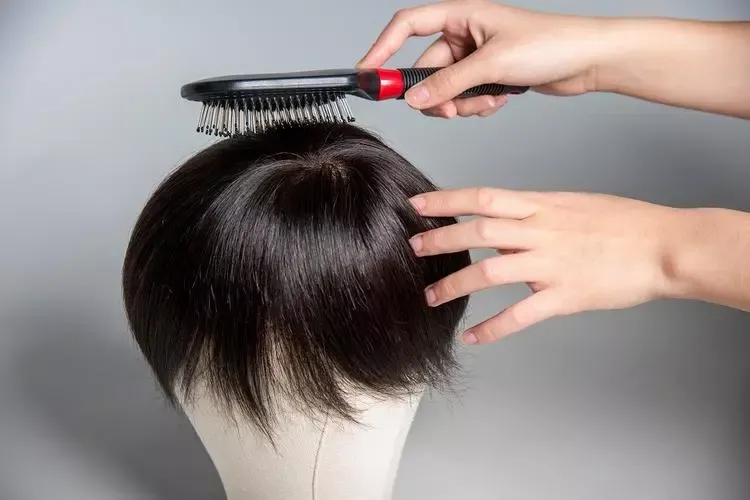Unlock the Secret to Vibrant Wig Beauty: Your human hair wig is more than just a fashion statement—it’s an investment in confidence and style. Discover the key to preserving its shine, shape, and durability through proper care. Join us as we explore the art of cleaning, uncovering the perfect frequency to maintain your wig’s allure and charm.
Understanding Cleaning Frequency: Factors to Consider
Determining how often to clean your human hair wig depends on various factors, including your lifestyle, environment, and how frequently you wear the wig. Here are some key considerations to keep in mind:
1. Frequency of Wear:
- Daily Wear: If you wear your wig daily, you’ll need to clean it more frequently to remove buildup from sweat, oils, and styling products.
- Occasional Wear: For wigs worn less frequently, such as for special occasions or events, cleaning may be less frequent but is still necessary to prevent dust and dirt accumulation.
2. Environmental Factors:
- Humidity: High humidity levels can contribute to moisture buildup in the wig, making it more prone to tangling and matting. In humid climates, you may need to clean your wig more often.
- Pollution: If you live in a heavily polluted area or are exposed to pollutants regularly, your wig may require more frequent cleaning to remove dirt and pollutants that can dull its appearance.
3. Personal Hygiene:
- Scalp Condition: Individuals with oily scalp conditions may transfer more oil to their wigs, necessitating more frequent cleaning.
- Skin Sensitivity: If you have sensitive skin or allergies, keeping your wig clean is essential to prevent irritation and discomfort.
4. Styling Products:
- Product Buildup: The use of styling products such as hairspray, gel, or mousse can leave residue on the wig, leading to stiffness and dullness. Regular cleaning helps remove product buildup and keeps the wig looking fresh.
5. Wig Type and Construction:
- Cap Construction: The type of cap construction (e.g., lace front, monofilament, or traditional wefted cap) can influence cleaning frequency. Wigs with lace fronts or monofilament caps may require more delicate handling and less frequent washing to preserve their structure.
- Hair Density and Length: Wigs with thicker density or longer hair may trap more dirt and require more frequent cleaning to maintain their appearance.
Practical Cleaning Tips for Human Hair Wigs
Now that we’ve discussed the factors that influence cleaning frequency, let’s explore some practical tips for cleaning your human hair wig effectively:
1. Brushing and Detangling:
- Before washing your wig, gently brush it with a wig brush or wide-tooth comb to remove tangles and knots. Start from the ends and work your way up to avoid causing damage to the hair fibers.
2. Pre-Wash Treatment:
- For heavily soiled wigs or wigs with stubborn buildup, consider applying a pre-wash treatment to help loosen dirt and oils. You can use a specially formulated wig shampoo or a diluted solution of gentle shampoo and water.
3. Washing Frequency:
- As a general rule of thumb, aim to wash your human hair wig every 8 to 12 wears. However, adjust the frequency based on the factors mentioned earlier, such as lifestyle and environmental conditions.
- If you notice an accumulation of dirt, oil, or styling products, it’s best to wash the wig sooner rather than later to prevent damage.
4. Choosing the Right Products:
- Use high-quality, sulfate-free shampoo and conditioner specifically designed for human hair wigs. Avoid products containing harsh chemicals or alcohol, as they can strip the hair of its natural oils and cause dryness.
- Consider using a leave-in conditioner or detangling spray to keep the hair soft, manageable, and hydrated between washes.
5. Washing Technique:
- Fill a sink or basin with lukewarm water and add a small amount of wig shampoo. Gently swish the wig in the water and distribute the shampoo evenly throughout the hair.
- Avoid rubbing or wringing the wig, as this can cause tangling and damage to the hair fibers. Instead, gently squeeze the shampoo through the hair from root to tip.
6. Rinse Thoroughly:
- After shampooing, rinse the wig thoroughly with lukewarm water until all traces of shampoo are removed. Be sure to rinse the inside of the cap as well to remove any product residue.
- Follow up with a generous application of conditioner, focusing on the mid-lengths and ends of the hair. Allow the conditioner to sit for a few minutes before rinsing it out.
7. Drying:
- Gently blot the wig with a towel to remove excess water, taking care not to rub or wring the hair.
- Place the wig on a wig stand or mannequin head to air dry naturally. Avoid using heat styling tools or exposing the wig to direct sunlight, as this can cause damage to the hair fibers.
8. Styling and Maintenance:
- Once the wig is dry, gently brush or comb through the hair to style it as desired. Use heat styling tools sparingly and always use a heat protectant spray to prevent heat damage.
- Store the wig in a cool, dry place away from direct sunlight when not in use. Consider covering it with a hair net or silk scarf to protect it from dust and moisture.
Conclusion
Cleaning your human hair wig is an essential part of maintenance that helps preserve its beauty, shape, and longevity. By considering factors such as frequency of wear, environmental conditions, and styling habits, you can determine the optimal cleaning schedule for your wig. By following the practical tips outlined in this guide, you can ensure that your human hair wig remains in pristine condition for years to come.


